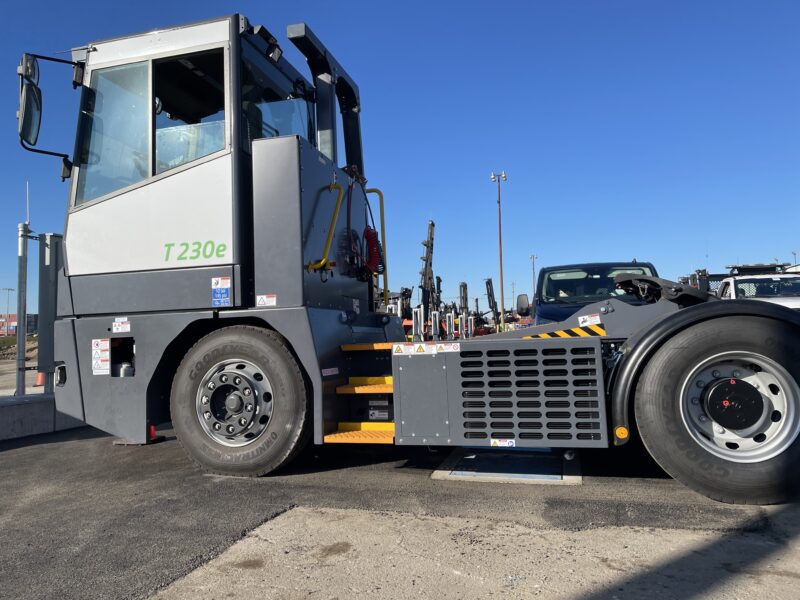
Sign up for daily news updates from CleanTechnica on email. Or follow us on Google News!
It wasn’t that long ago that the idea for electric vehicle wireless charging was hatched, and there have been many pilot projects. At CleanTechnica, we have published a variety of articles about wireless charging, including road-embedded technology. It might be possible to drive an EV and have it charge at the same time, meaning it would not be necessary to stop driving to charge unless the driver wanted to take a rest break and decided to charge manually. Another use case could be if an electric vehicle was left unattended in a parking lot or garage and was placed over a wireless charging pad so it could receive periodic transmissions of electricity, thus keeping the battery at a healthy state of charge. Such possibilities might seem like pipe dreams far off in the future. However, it was recently announced that wireless charging pads will soon be installed at the Port of Long Beach to be used by electric cargo vehicles.
John F. Rizzo, President and CEO of InductEV, answered some questions about the port’s wireless charging technology for CleanTechnica.
What can it charge and how many cargo vehicles can be charged at the same time?
InductEV’s wireless charging systems can be integrated into most vehicles, enabling use by mixed vehicle fleets, with a primary emphasis on commercial and transit fleets. The benefit of wireless charging on route is the ability to share one charger across many vehicles, normally on an ‘attach rate’ basis of six or four vehicles sharing one wireless charger, compared to one wired charger per vehicle in a centralized depot charging scenario. This means that wireless charging infrastructure is less expensive per vehicle than wired. One charger can provide power to a single vehicle at any given time, though since chargers can be placed along vehicle routes, many vehicles can use one charger over the course of a day. In this project, ITS will be able to charge five of its CHE with one charger.

What are the charge rates?
Currently, InductEV offers nominal charge rates from 75 kW to 450 kW+. The installation of Port of Long Beach will be 5 x 150 kW chargers. In general, the battery state of charge increases one percent per minute of charge time, or 1 mile per minute.
How long does it take to charge electric cargo vehicles using wireless technology?
Wireless chargers can charge more rapidly on a total basis than wired chargers because when parked over a charging pad, full power charging begins within 2 seconds. Having a driver park, plug a cable in, or having an overhead pantograph system or robotic arm requires minutes to set up and engage, losing valuable charging time and reducing the active use of the charging infrastructure. InductEV’s wireless charging technology achieves 90% power efficiency measured from grid to battery, on par with the standard operating efficiency of conventional plug-in DCFC chargers, delivering and thus delivering similar charging speeds. Wireless charging enables vehicles to leverage on-route opportunity charging in shorter, more frequent sessions by placing chargers at regular stops throughout the vehicles’ duty cycles. A standard opportunity charging session for cargo handling equipment may be between 5-15 minutes, with several charging sessions throughout the day, with the aim to maintain a vehicle state of charge of 40-70% without taking the vehicle out of service to recharge.
What are some advantages for wireless charging instead of the typical EV chargers that use cables? Is one that there are no cables that can be stolen or get damaged?
Yes, InductEV’s charging system has no moving or exposed parts due to our flush mount charging pads, eliminating the risk of damage from collision, user error, and vandalism. The charging system is also designed with reliability and resiliency built in; with a modular, 75 kW design, if one 75 kW charging module fails within a 150 kW charging pad, the other pad will continue to operate. The system’s modularity also facilitates an easier and faster replacement/repair process, as the module can swiftly be swapped as needed.
Wireless charging on route with properly designed routes and infrastructure provides unlimited range to the vehicle. The technology, for the first time, allows a full one to one replacement of a diesel vehicle fleet, with electric, with no range issues. Today most fleet operators must increase the number of electric vehicles in their fleets by 40% to achieve the same route performance and distance as diesel, dramatically increasing the vehicle cost to achieve route performance parity.
Wireless chargers also take up no incremental real estate for concrete aprons and bollards which is critical given the limitations in urban areas to charge larger number of vehicles in one location. Wireless chargers sit under the vehicle and the power electronics can be located up to 100 feet away, making installation much more efficient.
Wireless charging allows fleet operators to take advantage of on-route opportunity charging, which enables fleet electrification with fewer chargers and fewer vehicles, saving substantial capital, infrastructure, and operational costs. Traditional plug-in charging requires vehicles to be taken out of service to recharge at a depot or domicile location, resulting in a loss of usable hours and impacting the operator’s return on investment for that vehicle. A back-up vehicle may then need to be deployed to resume operations while the original vehicle recharges, particularly if vehicles struggle to meet the range of the ICE vehicles they’re intended to replace. With wireless on-route charging, the original vehicle can complete its entire duty cycle without returning to base. With a properly implemented system, this allows for 1 to 1 replacement of ICE vehicles with EVs, reducing the capital and operational outlays for electrification.
Additionally, with wireless charging being completed on-route throughout the day, charging does not occur all at once or in one single location, therefore reducing the total number of chargers needed when compared to plug-in charging and reducing the need for costly and time consuming utility upgrades required by traditional charging depots. This also allows for mitigation of utility demand charges, as well as energy cost optimization by allowing vehicles to selectively charge when advantageous.
How many charging pads will be installed, and when will they be operating?
For InductEV’s portion of the project, we will install five 150 kW wireless chargers for five electric yard tractors. We expect these to be operational in 2025.
What is the cost compared to conventional chargers?
Wireless charging can deliver significant savings in total cost of ownership compared to conventional plug-in chargers, typically savings of more than 25%.
Chip in a few dollars a month to help support independent cleantech coverage that helps to accelerate the cleantech revolution!
Have a tip for CleanTechnica? Want to advertise? Want to suggest a guest for our CleanTech Talk podcast? Contact us here.
Sign up for our daily newsletter for 15 new cleantech stories a day. Or sign up for our weekly one if daily is too frequent.
CleanTechnica uses affiliate links. See our policy here.
CleanTechnica’s Comment Policy

